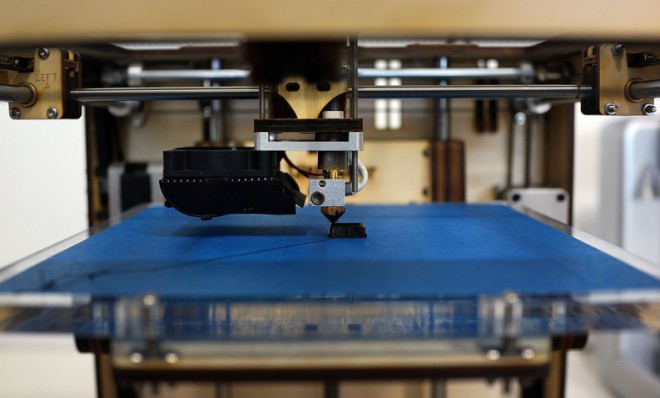How 3D printing could take over the manufacturing industry
Imagine a machine that could disassemble old unwanted objects, and use the materials to print new objects — all in the comfort of your own home

The laptop I typed this article on is the culmination of a vast, sprawling, and elaborate process over many continents, using many resources, many people, and many machines.
My laptop's construction incorporates plastics built out of crude oil, metals mined in Africa and forged into memory in Korea and semiconductors in Germany, and an aluminium case made from bauxite mined in Brazil. Gallons and gallons of refined oil were used to ship all the resources and components around the world, until they were finally assembled in China, and shipped out once again to the consumer. That manufacturing process stands upon the shoulders of centuries of scientific research, and years of product development, testing, and marketing.
The manufacturing industry today is a huge mesh of complex processes. Capitalism and the systems that it builds are the product of an evolutionary process gradually adjusting around consumer demand and the imperative of maximizing profit. Just as the internet has revolutionized communications and the distribution of information, new technologies already exist that if widely adopted may do the same thing for manufacturing.
The Week
Escape your echo chamber. Get the facts behind the news, plus analysis from multiple perspectives.

Sign up for The Week's Free Newsletters
From our morning news briefing to a weekly Good News Newsletter, get the best of The Week delivered directly to your inbox.
From our morning news briefing to a weekly Good News Newsletter, get the best of The Week delivered directly to your inbox.
3D printers allow physical objects to be designed digitally and printed using physical materials — mostly plastic, but increasingly almost anything (including human cells). Designs can be shared — or bought and sold — through the internet. Already, there are schematics for cars, homes, guns, sex toys, and all manner of trinkets and household items.
The technology is about 30 years old, but with the costs of the machinery rapidly falling — entry-level, fully assembled 3D printers are now for sale for under $500 — 3D printing is poised to move into the mainstream.
Home-based 3D printing has the potential to lower costs, and decentralize and democratize manufacturing, especially as technologies improve and as more complex multi-material printers become available. While buyers of entry-level equipment are mostly limited to plastic trinkets at present, the sky is the limit. As technology improves, sooner or later the elaborate process of building a computer could be reduced to home manufacture via 3D printer. For cost and convenience, 3D printing at home could become the new normal. That would eliminate a great amount of the costs currently associated with global manufacturing, and ease dependency on fragile global supply chains. It could also drastically reduce the barriers to entry to industrial design and manufacturing, allowing for an influx of new competitors, unleashing a flood of creativity and increasing consumer choice.
An equally exciting possibility: The eventual creation of a disassembler, also known as a Santa Claus Machine, that could recycle household and industrial waste into materials to be reused in a 3D printer. Households could simply disassemble old unwanted objects, and use the materials to print new objects. Combined with a cheap source of renewable energy like solar panels, many households and communities could become very self-sufficient.
A free daily email with the biggest news stories of the day – and the best features from TheWeek.com
Of course, there are already some legal problems. The U.S. State Department recently demanded that schematics for a 3D-printed gun be taken offline. A schematic has been published for handcuff keys, as well as another to create cash machine skimmers that could be used to steal credit card details. And the technology poses a massive challenge to any concept of intellectual property — 3D scanners can scan the physical characteristics of an object, allowing for the easy reproduction of just about anything.
So like with any industrial revolution, there will be challenges and difficulties. As happened with the internet, some people will use new technology for crime and terrorism. The economist Joseph Schumpeter once wrote that "economic progress in capitalist society means turmoil." But like with the internet, it seems probable that the upsides of 3D printing will greatly outweigh the downsides.
Still, the 3D printing revolution may not be as swift as we'd like. For example, although online commerce has allowed businesses and consumers to cut out the middleman, still only 5 percent of all retail sales are done online. Progress is a slow process, and it is hard to predict precisely the time when society will adopt a new technology, system, or idea en mass. But as 3D printing technology spreads, its potential to lower costs and increase convenience has the potential to make the impact of the internet look rather small.
John Aziz is the economics and business correspondent at TheWeek.com. He is also an associate editor at Pieria.co.uk. Previously his work has appeared on Business Insider, Zero Hedge, and Noahpinion.
-
 7 bars with comforting cocktails and great hospitality
7 bars with comforting cocktails and great hospitalitythe week recommends Winter is a fine time for going out and drinking up
-
 7 recipes that meet you wherever you are during winter
7 recipes that meet you wherever you are during winterthe week recommends Low-key January and decadent holiday eating are all accounted for
-
 Nine best TV shows of the year
Nine best TV shows of the yearThe Week Recommends From Adolescence to Amandaland